Turbochargers are one of the greatest automotive innovations of the 20th century.
Turbocharged Diesel Engines | Trucking Smart
Closed Caption
Introduction
Hi there smart drivers, Rick with Smart Drive Test talking to you today about turbochargers.
Yes one of the greatest inventions of the 20th century.
And any professional driver operating a diesel engine bus or big truck or your pickup truck - these are all going to have turbochargers on them in this day and age.
We're going to give you some information about that.
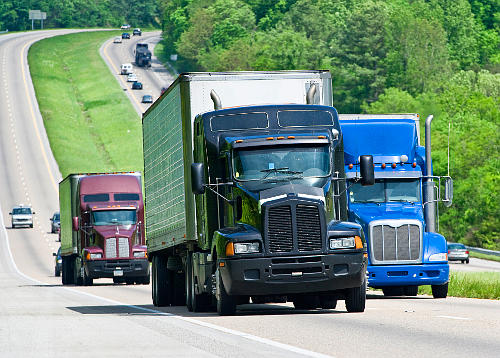
I was coming back from Vancouver the other day, and I saw the big truck on the proverbial hook--being towed-- obviously broke down - unfortunate for the driver.
Anyway you can see here in the image that there are bags over the top of the exhaust stacks.
Stick around to the end of the video and I'll tell you why the bags are over the top of the exhaust stacks.
So today we're going to give you some information about turbochargers.
We'll right back with that information.
Stick around.
Greatest Automotive Innovations
Hi there smart drivers, welcome back.
Rick with Smart Drive Test talking to you today about the turbocharger.
No doubt the turbocharger is one of the greater automotive innovations of the 20th century.
It's right up there with the electric starter, the automatic transmission, radial tires, and electronic fuel injection.
The turbocharger gives you far more power out of an internal combustion engine.
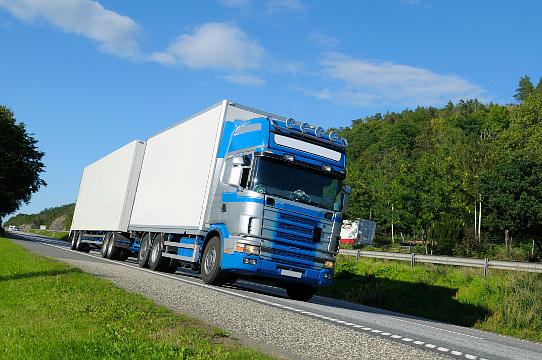
Faster....Harder
And you need two things to make an internal combustion engine go faster and give you more power:
1) you need fuel;
2) and you need air.
Fuel's easy - you just put a bigger pump on it; put a bigger carburetor on, and it'll go faster.
The problem, or the challenge, becomes more air into the motor.
Most vehicles that don't have a supercharger on them and don't have a turbocharger on them are called 'naturally aspirated.'
So it means that it just relies on air pressure to push air into the motor.
Now if you want to make the motor more powerful and go faster, you need more air.
Because fuel's easy! So one of the ways that we do that is we do that with superchargers and we do that with turbochargers.
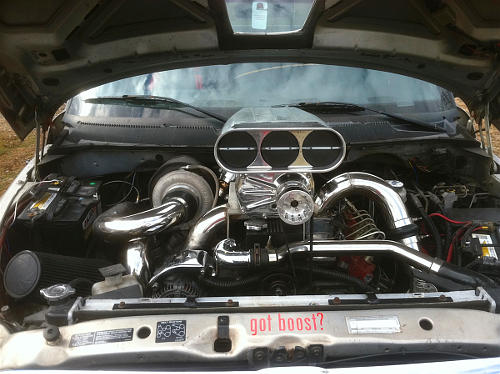
Better than a Supercharger
Now turbocharges are far better than supercharges because they're not parasitic, which means that they don't take energy out of the motor to give you more energy as a supercharger does.
However a supercharger works far better off the line; in other words, right off the bottom.
And the supercharger will give you far more power, whereas a turbocharger tends to be a top end power.
So once you get the vehicle working, get some rpms (revolutions per minute) and get some exhaust gases, you're going to get more power out of a turbocharger.
And they fixed that too!
Don't Work the Day for Free:: DOT Weigh Scale Checklist |
||
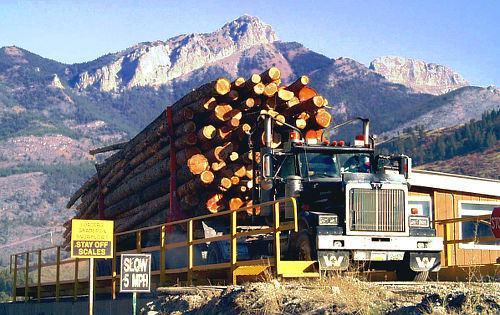
• DID YOU KNOW? :: Bus & truck drivers are the only drivers that have their own police force (DOT, CVSE, MTO, etc.);• SMART :: There's a lot of paperwork you must produce for authorities at the weigh scale;• SELF-CONFIDENCE :: Bring all paperwork in one hit & impress the diesel bears! |
||
Because in most cases, it's you that gets the fine...NOT the company! |
Launch Control
And now a turbocharger can act like a supercharger with something called 'launch control,' which is essentially the vehicle will not engage and go forward until the engine attains about 5,000 RPM.
By the time the engine attains 5000 rpm you're generating enough exhaust gases that the turbo is spooled up and it takes off.
It's called launch control.

The Mechanics of a Turbocharger
So a turbocharger is a very simple mechanism and you can see here in the image that it's two turbines.
And essentially a turbine is a fan.
It's the same thing in a hydroelectric dam - you've got a turbine that the water spins.
On the side of the diesel engine, you've got exhaust gases that come out of the motor and spin a turbine - essentially spins a fan.
In turn that fan turns another turbine that creates vacuum and sucks air into the engine and often pushes it through an intercooler, which is essentially just a radiator in front of the main radiator of the engine.
And then forces it--am forces--it into the motor.
Now the other thing about turbocharges that's really great is its on-demand power.

History
Now just a little bit of history about turbochargers.
When they first invented turbochargers they had difficulty keeping bearings in the turbocharger because they spin at such a high rate.
A turbocharger can spin anywhere from fifty to a hundred thousand rpms - that's revolutions per minute.
So they spin at a very, very high speed.
[TURBOCHARGER SPOOLING UP IN BACKGROUND]
And when they spool up - when the engine starts to create exhaust gases and the turbocharger spools up you can hear that in the truck or the diesel engine and often what I tell students, as soon as the turbo starts to spool up and your shifting, that's when you want to shift the gear.
Because once it spools up it's just going to wind out after that and you're not creating maximum power and you're not in that maximum power band on the RPM.

So two things about the turbocharger:
1) it's not parasitic - it doesn't take any power from the motor to make it work;
2) and second its on-demand power.
So when you need power, the turbocharger is working and creating more power in the motor because it's ram forcing more air into the engine.
So the turbocharger is really great.
Intercooler
Turbocharged engines are equipped with an intercooler.
The purpose of the intercooler is to cool down the air that is coming out of the turbocharger.
Because the turbocharger works on exhaust gases it is really hot - hundreds of degrees Celsius.
And the air coming out of the turbocharger is superhot, so it's forced through the intercooler, which is essentially another radiator in front of the main radiator that cools the engine.

It cools down the air and makes the air denser, and when the air is denser you can have a richer fuel to air mixture that is ram forced into the engine.
And when you get a richer and higher fuel content and air content that goes into the combustion chamber on top of the piston, you get a more powerful explosion.
Thus you get more power out of your motor.
So most turbochargers are going to be also equipped with an intercooler which is going to give you the driver even more power.
Origins of the Turbocharger
A little bit of history about the turbocharger.
When they first invented turbochargers they tried to put bearings in them, but because they spin at such a high rate they couldn't keep bearings in them - they kept tearing bearings out of them.
So eventually what they did after some trial and errors, they put ceramic bushings in them and then pumped oil through the bushings on a constant basis.
So the whole time that the engine is running, there is oil being pumped into the bushings--the ceramic bushings in the turbocharger--because it spins 50-100,000 thousand rpm.

And in the old days--the initial days of turbochargers--what would happen, was that somebody jumped in their car-- they're turbocharged car--go running to the beer store at ten to six on a Friday night because the beer store closed at six.
Drive into the parking lot--go screaming into the parking lot with the turbocharger still whining over at 50,000 RPM and shut the motor off.
And when they shut the motor off, they shut the oil supply off to the turbocharger.
When they shut the oil supply off, they burned the bushings out in the turbocharger and the turbocharger was no longer good.
Spooling Down
So if you're pulling hard, you're pulling heavy, and you come in somewhere--into a parking lot of what not--often times you need to let it run for a minute or two to let the turbocharger spool down.

That way you're not going to create damage to the turbocharger.
And Peterbilts actually have a timer on them--some of the trucks actually have timers on them that you can set so the motor will stay running for a couple of minutes and then it'll shut down.
So when you park in the parking lot you can do that with the timer on the dash - just set it and that way the turbocharger will spool down.
Now it doesn't take very long for it to spool down - it's pretty quick, so you don't have to leave the truck running for five or ten minutes - just a couple of minutes, and the turbocharger will have a spooled down.
Sacs on Stacks
Last point: why were their bags over the exhaust stacks on the truck that was being towed?
The reason that there's bags over the exhaust stacks is because when the vehicle is being towed backwards down the highway at a hundred kilometers an hour (62mph) there's wind forced down into the exhaust stacks and it spins that turbine inside the turbocharger.
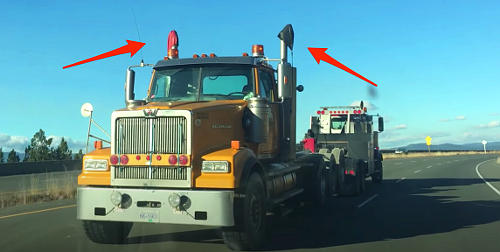
Because the engine is not running, there's no oil supply to the turbo.
And if you're going a distance on the hook, going down the road, with that turbine is spinning, you'll burn the turbo out.
That's why there's bags over top of the exhaust stacks on the truck that's being towed.
Question for my smart drivers:
Have you ever burned out a turbocharger?
Leave a comment down in the comment section there and tell us why you think the turbocharger burned out.
Thanks very much for watching, I'm Rick with Smart Drive Test.
If you like what you see here share, subscribe, leave a comment down in the comment section.
As well, hit that thumbs up button.
Good luck on your road test and remember pick the best answer, not necessarily the right answer.
Have a great day.
Bye now.
